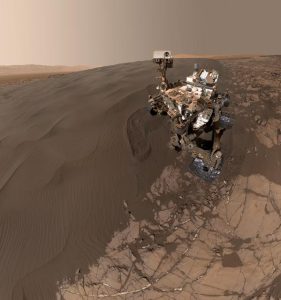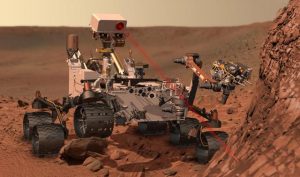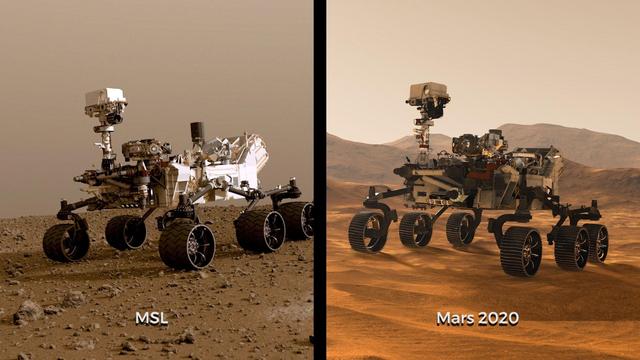For eight years, Curiosity has roamed the surface of the red planet. The car-sized rover journeyed to Mars to answer one very important scientific question: Was the Martian environment ever habitable?

Curiosity didn’t have to wait long to find the answer. The roaming rover soon discovered mineral and chemical evidence of past habitable Martian environments.
Curiosity, which launched on Nov. 26, 2011, landed in Gale Crater on Aug. 6, 2012, which it continues to explore today. It has been on the red planet for over 2,800 Sols (Martian day), taken more than 700,000 raw images and traveled over 14 miles on the surface of Mars.
Thanks to Curiosity, scientists now know much more about the planet.
This week we remember the historic landing of Curiosity, the beginning of an ongoing quest for answers about Mars’ past, with five fast facts about the mission.
1. Curiosity has another name.
While most people know it as Curiosity, this Martian rover also goes by another, more technical name: The Mars Science Laboratory.

Since its official name is quite long, it is often just referred to by its common name, Curiosity. In fact, NASA uses the names interchangeably, although it should be noted that the mission itself is the Mars Science Laboratory mission.
2. Curiosity’s power system has far exceeded its operational lifespan.
Curiosity is equipped with a radioisotope power system. In this kind of system, electricity is generated by the heat given off from plutonium’s radioactive decay.
According to NASA, this power source has exceeded its required operational lifespan, which was at least one Martian year, or 687 Earth days.
The fact that Curiosity has been roving around on the surface of Mars for eight years is a testament to its design.
3. Curiosity snapped a 1.8 billion-pixel panorama on Mars.
According to NASA, this 1.8 billion-pixel panorama (featured in the video below) is the largest and highest resolution panorama the rover has ever captured.
As if that isn’t cool enough, the panorama yielded some important discoveries about the history of water on Mars.
4. The Mars Science Laboratory mission tested an entirely new landing method.
When Curiosity landed on Mars, it was a big deal. Not only was it the largest rover to land on the red planet, but a new landing system was also tested.

The new landing procedure first had the spacecraft descend to the surface via parachute (see image to the right, taken by the Mars Reconnaissance Orbiter). Then, during the final seconds prior to touching down on Martian soil, the landing system fired rockets so it would hover above the surface while a tether lowered Curiosity safely onto Mars.
The tether was then severed, and the landing system flew away to crash land.
Curiosity landed wheels down, ready to explore. The new landing method was a success!
5. NASA’s Mars 2020 Perseverance rover is based off Curiosity’s design.
According to NASA, to keep both risks and cost low, the new Mars 2020 rover, or Perseverance, was architecturally modeled after Curiosity.
Perseverance will be taking things one step further than Curiosity by searching for signs of past microbial life. Past missions have been centered around whether habitable conditions existed for life on Mars, but NASA’s Mars 2020 rover will attempt to assess both past habitability and search for signs of past life on the Martian world. Pretty exciting, right?
Perseverance launched on July 30, and is scheduled to land in Mars’ Jezero Crater on Feb. 18, 2021!

Learn more about Curiosity here and check back next week for another Mission Monday story!








